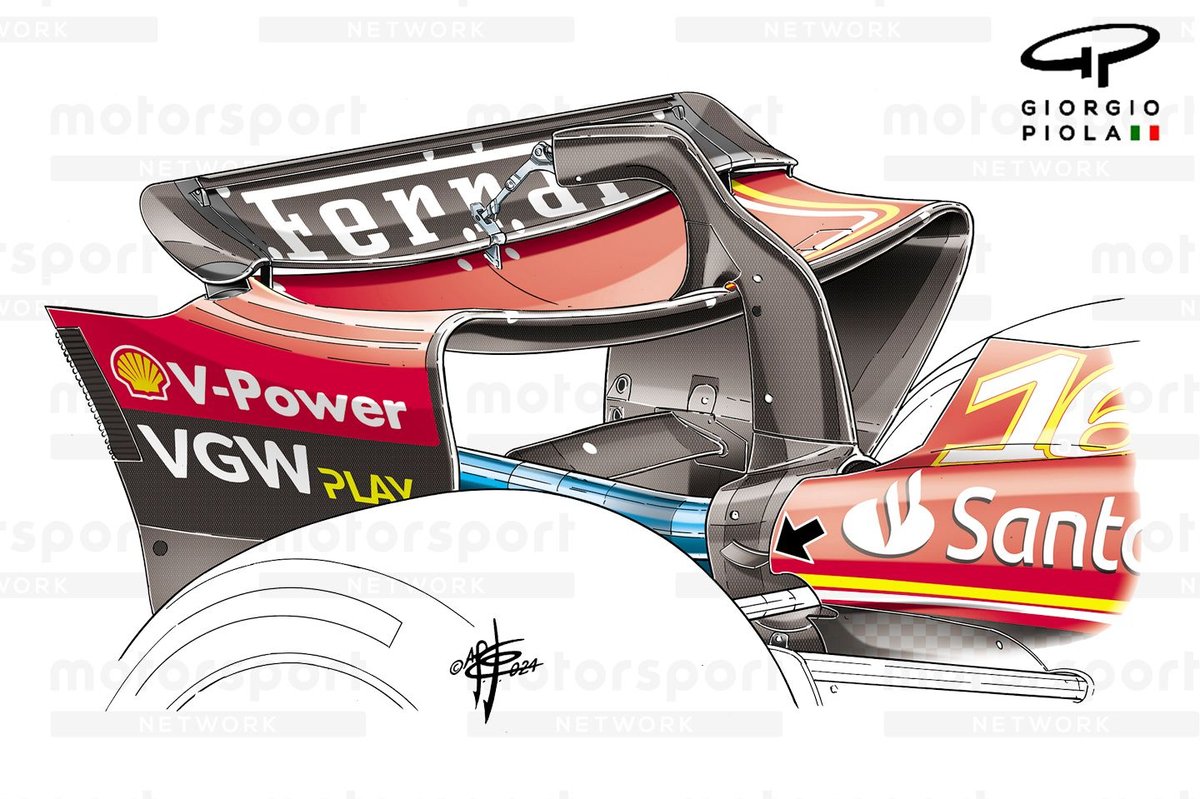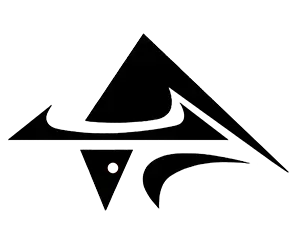
Ferrari’s New Winglet Design: A Game-Changer for the SF-24
Ferrari has once again proven their innovative prowess with the introduction of a new winglet design on their SF-24 car. This simple yet effective solution has caught the attention of the entire Formula 1 community, and for good reason.
Located on either side of the curved exhaust surround and rear wing pillar mounting, these winglets have not been seen in this specific location before. It’s surprising that no other team has thought to utilize this space, especially considering the trend of adding aerodynamic surfaces wherever possible in F1.
But now that Ferrari has broken the mold, it’s likely that other teams will follow suit and add their own versions of these pylon winglets. The purpose of these winglets is to redirect some of the heat being rejected from the engine cover outlet and improve the flow downstream to the beam wing.
Ferrari’s Switch to a Single Element Beam Wing Configuration
In addition to the new winglet design, Ferrari also made a significant change to their beam wing configuration for the Australian Grand Prix. They opted for a single element beam wing instead of their usual bi-plane style arrangement.
This decision was based on the demands of the Albert Park circuit, as the team had initially tested their bi-plane wing during practice on Friday. The rear wing remained in the same configuration as the first two races, with their new, lower downforce configuration still under wraps.
Aston Martin’s Front Wing Upgrade
Aston Martin also made a notable change to their front wing in Australia, with a new spanwise twist distribution on the upper two flaps. This alteration was made to improve the overall performance of the wing and the car as a whole.
In addition to the flap profile change, the team also removed one of the metal support brackets in the center of the lower flap. This new design is similar to the one used by Mercedes since the beginning of this regulatory phase.
Sauber’s Extensive Front Wing Overhaul
Sauber took a more drastic approach with their front wing upgrade, switching to a semi-detached flap and endplate juncture similar to Mercedes. This design aims to increase outwash while still generating the necessary downforce.
The upper two elements of the front wing now have a detached flap section with angled endplates, and two winglets have been added to create vorticity and work with other surfaces in the region. Unfortunately, damage to Zhou Guanyu’s front wing during qualifying meant he had to start the race from the pitlane as the team did not have any spare parts of this new configuration.
Red Bull’s Technical Detail
Red Bull Racing also made some changes to their RB20 car, with a new technical detail spotted on the car during the Australian Grand Prix. This detail, captured by Giorgio Piola, shows a new design on the side of the car that could potentially improve aerodynamics and overall performance.
Kosport Magazine: Your Source for the Latest F1 News
Stay updated on all the latest Formula 1 news and developments with Kosport Magazine. Our team of experts provides in-depth analysis and coverage of all the races, teams, and drivers. Don’t miss out on any of the action, subscribe to Kosport Magazine today!
Red Bull Continues to Push the Limits in F1 Development
As the 2024 Formula 1 season kicks off, all eyes are on Red Bull Racing as they continue to push the boundaries of development. Despite not having any new components at the Australian Grand Prix, the team is still hard at work behind the scenes.
In the early stages of FP1, Red Bull rigged Max Verstappen’s car with additional cameras and placed markers on the front upper wheel wake deflector panel to study its flexibility. This shows the team’s dedication to constantly improving and optimizing their car.
But it’s not just about the cameras and markers. Red Bull has also been experimenting with different rear wing configurations, with three different designs appearing in the first three races of the season. This approach sets them apart from other teams and allows them to tailor their car to the specific demands of each circuit.
The general design of the rear wing remains consistent, with a spoon-shaped mainplane and semi-detached tip section. However, subtle changes are made to target the desired level of downforce and drag. And while the overall design may stay the same, the team is not afraid to make adjustments, as seen with the different rear wing configurations used in Australia, Bahrain, and Saudi Arabia.
One thing that has remained consistent is the use of a single element beam wing to help depower the assembly. This, combined with the team’s innovative designs, has allowed them to stay competitive and challenge for podium finishes.
Red Bull’s Impressive Repertoire
Red Bull’s dedication to development and innovation has not gone unnoticed. As the only team to take such a diverse approach to rear wing configurations, they have established an impressive repertoire in the early part of the season.
But it’s not just about the rear wing. Red Bull has also been making headlines with their driver lineup. With the addition of Sergio Perez and the impressive performance of Yuki Tsunoda, the team is looking stronger than ever.
However, team principal Christian Horner has made it clear that even with their strong lineup, they are always looking for ways to improve. In an interview with Kosport Magazine, Horner stated, “We are constantly pushing the limits and looking for ways to improve. We couldn’t rule out any potential changes to our driver lineup in the future.”
With Red Bull’s dedication to development and their impressive repertoire, it’s clear that they are a force to be reckoned with in the 2024 Formula 1 season.
Short Resume:
Red Bull Racing continues to push the boundaries of development in the 2024 Formula 1 season. Despite not having any new components at the Australian Grand Prix, the team is constantly working behind the scenes to improve their car. With innovative designs and a diverse approach to rear wing configurations, Red Bull has established an impressive repertoire. And with a strong driver lineup, including the addition of Sergio Perez and the impressive performance of Yuki Tsunoda, the team is looking stronger than ever. But they are not resting on their laurels, as team principal Christian Horner has stated that they are always looking for ways to improve. With their dedication to development, Red Bull is a force to be reckoned with in the 2024 season.
Red Bull Junior Iwasa to Make F1 Debut in Japan
As the Formula 1 season heats up, Red Bull Racing has announced that their junior driver Ayumu Iwasa will be making his F1 debut at the Japanese Grand Prix. This news has sent shockwaves through the racing world, as the 19-year-old Japanese driver has been making waves in the lower formulae.
Iwasa, who is currently competing in the FIA Formula 3 Championship, will be taking part in the first practice session for Red Bull Racing at Suzuka Circuit. This opportunity comes as a result of his impressive performances in the junior categories, catching the eye of Red Bull’s driver development program.
With the Japanese Grand Prix being a home race for Iwasa, the young driver is eager to make the most of this opportunity and showcase his talent on the world stage. “I am incredibly grateful for this opportunity and I will do my best to make the most of it,” Iwasa said in a statement.
This news has also sparked speculation about the future of Red Bull’s current junior driver, Yuki Tsunoda. The 21-year-old Japanese driver has been impressive in his rookie season with AlphaTauri, but Red Bull’s motorsport advisor Helmut Marko believes he still has room for improvement before being considered for a seat at Red Bull Racing.
“Tsunoda has shown great potential, but he still needs to improve in certain areas before he can be considered for a seat at Red Bull,” Marko stated in an interview with Kosport Magazine.
A Bright Future Ahead
With Iwasa’s F1 debut and Tsunoda’s promising performances, it’s clear that Japan has a bright future in Formula 1. Both drivers have shown immense talent and determination, and it’s only a matter of time before they make their mark on the sport.
As for Iwasa, this opportunity could be the start of a successful career in Formula 1. With Red Bull’s strong track record of developing young drivers, Iwasa has the potential to become a future star in the sport.
But for now, all eyes will be on Iwasa as he takes to the track at Suzuka Circuit for his F1 debut. It’s sure to be an exciting moment for the young driver and for Japanese motorsport as a whole.
Summary:
Red Bull Racing has announced that their junior driver Ayumu Iwasa will be making his F1 debut at the Japanese Grand Prix. The 19-year-old Japanese driver has been making waves in the lower formulae and will be taking part in the first practice session for Red Bull Racing at Suzuka Circuit. This news has also sparked speculation about the future of Red Bull’s current junior driver, Yuki Tsunoda, with Red Bull’s motorsport advisor Helmut Marko stating that he still needs to improve before being considered for a seat at Red Bull. With Iwasa’s F1 debut and Tsunoda’s promising performances, it’s clear that Japan has a bright future in Formula 1.





